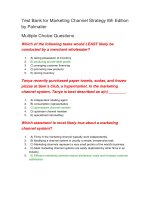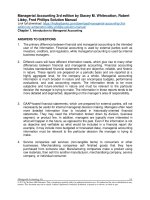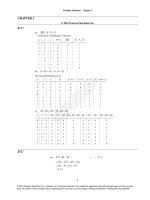Managerial economics and business strategy 8th edition by baye and prince solution manual
Bạn đang xem bản rút gọn của tài liệu. Xem và tải ngay bản đầy đủ của tài liệu tại đây (703.15 KB, 9 trang )
Chapter 02 - Market Forces: Demand and Supply
Managerial Economics & Business Strategy 8th edition by Michael R. Baye, Jeffrey T.
Prince Solution Manual
Link full download: />Chapter 2: Answers to Questions and Problems
1.
a. Since X is a normal good, a decrease in income will lead to a decrease in the
demand for X (the demand curve for X will shift to the left).
b. Since Y is an inferior good, an increase in income will lead to a decrease in the
demand for good Y (the demand curve for Y will shift to the left).
c. Since goods X and Y are substitutes, an increase in the price of good Y will lead
to an increase in the demand for good X (the demand curve for X will shift to the
right).
d. No. The term “inferior good” does not mean “inferior quality,” it simply means
that income and consumption are inversely related.
2.
a. The supply of good X will increase (shift to the right).
b. The supply of good X will decrease. More specifically, the supply curve will shift
vertically up by exactly $3 at each level of output.
c. The supply of good X will decrease. More specifically, the supply curve will
rotate counter-clockwise.
d. The supply curve for good X will increase (shift to the right).
3.
a. 𝑄𝑥𝑠 = −30 + 2(600) − 4(60) = 930 units.
b. Notice that although 𝑄𝑥𝑠 = −30 + 2(80) − 4(60) = −110, negative output is
impossible. Thus, quantity supplied is zero.
c. To find the supply function, insert Pz = 60 into the supply equation to obtain 𝑄𝑥𝑠 =
−30 + 2𝑃𝑥 − 4(60) = −270 + 2𝑃𝑥. Thus, the supply equation is 𝑄𝑥𝑠 = −270 +
2𝑃𝑥. To obtain the inverse supply equation, simply solve this equation for Px to
obtain 𝑃𝑥 = 135 + 0.5𝑄𝑥𝑠. The inverse supply function is graphed in Figure 2-1.
2-1
© 2014 by McGraw-Hill Education. This is proprietary material solely for authorized instructor use. Not authorized for sale or distribution
in any manner. This document may not be copied, scanned, duplicated, forwarded, distributed, or posted on a website, in whole or part.
Chapter 02 - Market Forces: Demand and Supply
$500
$400
$300
$200
$100
$0
0
100
200
300
400
500
Quantity of X
Figure 2-1
4.
a. Good Y is a complement for X, while good Z is a substitute for X.
b. X is a normal good.
c. 𝑄𝑥𝑑 = 6,000 − ($5,230) − $6,500 + 9($100) + ($70,000) = 4,785
d. For the given income and prices of other goods, the demand function for good X
is 𝑄𝑥𝑑 = 6,000 − 12 𝑃𝑥 − $6,500 + 9($100) +
($70,000) which simplifies to
𝑄𝑥𝑑 = 7,400 − 12 𝑃𝑥. To find the inverse demand equation, solve for price to obtain
𝑃𝑥 = 14,800 − 2𝑄𝑥𝑑. The demand function is graphed in Figure 2-2.
$16,000
$14,000
$12,000
$10,000
$8,000
$6,000
$4,000
$2,000
$0
0
1000
2000
3000
4000
5000
6000
7000
Quantity of X
Figure 2-2
2-2
© 2014 by McGraw-Hill Education. This is proprietary material solely for authorized instructor use. Not authorized for sale or distribution
in any manner. This document may not be copied, scanned, duplicated, forwarded, distributed, or posted on a website, in whole or part.
Chapter 02 - Market Forces: Demand and Supply
5.
a. Solve the demand function for Px to obtain the following inverse demand
function: 𝑃𝑥 = 150 − 12 𝑄𝑥𝑑.
b. Notice that when Px = $45, 𝑄𝑥𝑑 = 300 − 2(45) = 210 units. Also, from part a, we
know the vertical intercept of the inverse demand equation is 150. Thus, consumer
surplus is $11,025 (computed as (0.5)($150-$45)210 = $11,025).
c. When price decreases to $30, quantity demanded increases to 240 units, so
consumer surplus increases to $14,400 (computed as (0.5)($150-$30)240 =
$14,400).
d. So long as the law of demand holds, a decrease in price leads to an increase in
consumer surplus, and vice versa. In general, there is an inverse relationship
between the price of a product and consumer surplus.
6.
a. Equating quantity supplied and quantity demanded yields the equation 60 − 𝑃 =
𝑃 − 20. Solving for P yields the equilibrium price of $40 per unit. Plugging this
into the demand equation yields the equilibrium quanity of 20 units (since
quantity demanded at the equilibrium price is 𝑄𝑑 = 60 − (40) = 20).
b. A price floor of $50 is effective since it is above the equilibrium price of $40. As
a result, quantity demanded will fall to 10 units (𝑄𝑑 = 60 − 50), while quantity
supplied will increase to 30 units (𝑄𝑠 = 50 − 20). That is, firms produce 30 units
but consumers are willing and able to purchase only 10 units. Therefore, at a price
floor of $50, 10 units will be exchanged. Since Qd < Qs there is a surplus
amounting to 30-10 = 20 units.
c. A price ceiling of $32 per unit is effective since it is below the equilibrium price
of $40 per unit. As a result, quantity demanded will increase to 28 units (𝑄𝑑 = 60
− 32 = 28), while quantity supplied will decrease to 12 units (𝑄𝑠 = 32 − 20 =
12). That is, while firms are willing to produce only 12 units consumers want to
buy 28 units at the ceiling price. Therefore, at the price ceiling of $32, only 12
units will be available to purchase. Since Qd > Qs, there is a shortage amounting to
28-12 = 16 units. Since only 12 units are available at a price of $32, the full
economic price is the price such that quantity demanded equals the 12 available
units: 12 = 60 – PF. Solving yields the full economic price of $48.
7.
a. Equate quantity demanded and quantity supplied to obtain 14 − 12 𝑃𝑥 = 14 𝑃𝑥 − 1.
Solve this equation for Px to obtain the equilibrium price of Px = 20. The
2-3
© 2014 by McGraw-Hill Education. This is proprietary material solely for authorized instructor use. Not authorized for sale or distribution
in any manner. This document may not be copied, scanned, duplicated, forwarded, distributed, or posted on a website, in whole or part.
Chapter 02 - Market Forces: Demand and Supply
equilibrium quantity is 4 units (since at the equilibrium price quantity demanded
is 𝑄𝑑 = 14 − (20) = 4). The equilibrium is shown in Figure 2-3.
$30
Supply
$25
$20
$15
Demand
$10
$5
$0
0
1
2
3
4
5
6
Quantity of X
Figure 2-3
b. A $12 excise tax shifts the supply curve up by the amount of the tax.
Mathematically, this means that the intercept of the inverse supply function
increases by $12. Before the tax, the inverse supply function is 𝑃 = 4 + 4𝑄𝑠.
After the tax the inverse supply function is 𝑃 = 16 + 4𝑄𝑠, and the after tax
supply function (obtained by solving for Qs in terms of P) is given by 𝑄𝑠 = 1 𝑃 −
4
4. Equating quantity demanded to after-tax quantity supplied yields 14 − 𝑃 =
𝑃 − 4. Solving for P yields the new equilibrium price of $24. Plugging this into
the demand equation yields the new equilibrium quantity, which is 2 units.
c. Since two units are sold after the tax and the tax rate is $12 per unit, total tax
revenue is $24.
8.
a. The shortage is 3 units (since at a price of $6, Q Qd
s
4
1
3
units). The full economic price is $12.
b. The surplus is 1.5 units (since at a price of $12, Q Qs d 2.5
1
1.5 units.
The cost to the government is $18 (computed as ($12)(1.5) = $18).
c. The excise tax shifts supply vertically by $6. Thus, the new supply curve is S1 and
the equilibrium price increases to $12. The price paid by consumers is $12 per
unit, while the amount received by producers is this $12 minus the per unit tax.
2-4
© 2014 by McGraw-Hill Education. This is proprietary material solely for authorized instructor use. Not authorized for sale or distribution
in any manner. This document may not be copied, scanned, duplicated, forwarded, distributed, or posted on a website, in whole or part.
Chapter 02 - Market Forces: Demand and Supply
Thus, producers receive $6 per unit. After the tax, the equilibrium quantity sold is
1 unit.
d. At the equilibrium price of $10, consumer surplus is .5 $14
Producer surplus is .5 $10
$2 2
$10 2
$4 .
$8 .
e. No. At a price of $2 no output is produced.
9.
a. The inverse supply curve is 𝑃 = 26 + 0.05𝑄.
b. When Qx = 400, producer surplus is (46-26)*400/2 = $4,000. When Qx = 1200,
producer surplus is (86-26)*1200/2 = $36,000.
10.
a. The cost of purchasing the surplus is $40*(24-12) = $480.
b. The deadweight loss resulting from a $40 price floor is 0.5 ∗ (40 − 28) ∗
(20 − 12) = $48.00.
11.
Rising input prices that increase production costs will lead to a leftward shift in the
supply curve for RAM chips, resulting in a higher equilibrium price of RAM chips. If
in addition, income falls, the demand for RAM chips will decrease since they are a
normal good. This decrease in demand would tend to decrease the price of RAM
chips. The ultimate effect of both of these changes in supply and demand on the
equilibrium price of RAM chips is indeterminate. Depending on the relative
magnitude of the decreases in supply and demand, the price you will pay for chips
may rise or fall.
12.
The tariff reduces the supply of raw sugar, resulting in a higher equilibrium price of
sugar. Since sugar is an input in making generic soft drinks, this increase in input
prices will decrease the supply of generic soft drinks (putting upward pressure on the
price of generic soft drinks and tend to reduce quantity). Coke and Pepsi’s advertising
campaign will decrease the demand for generic soft drinks (putting downward
pressure on the price of generic soft drinks and further reducing the quantity). For
these reasons, the equilibrium quantity of generic soft drinks sold will decrease.
However, the equilibrium price may rise or fall, depending on the relative magnitude
of the shifts in demand and supply.
2-5
© 2014 by McGraw-Hill Education. This is proprietary material solely for authorized instructor use. Not authorized for sale or distribution
in any manner. This document may not be copied, scanned, duplicated, forwarded, distributed, or posted on a website, in whole or part.
Chapter 02 - Market Forces: Demand and Supply
13.
No. this confuses a change in demand with a change in quantity demanded. Higher
cigarette prices will not reduce (shift to the left) the demand for cigarettes.
14.
To find the equilibrium price and quantity, equate quantity demanded and quantity
supplied to obtain 210 – 1.5P = 2.5P – 150. Solving yields the new equilibrium price
of $90 per pint. The equilibrium quantity is 75 units (since Qd = 210 – 1.5*90 = 75
units at that price). Consumer surplus is
surplus is
. Producer
. See Figure 2-4.
160
140
120
100
80
Supply
Consumer Surplus
Producer Surplus
Demand
60
40
20
0
0
20
40
60
80
100
Quantity
Figure 2-4
15.
This decline represents a leftward shift in the supply curve for oil, and will result in
an increase in the equilibrium price of crude oil. Since oil is an input in producing
gasoline, this will decrease the supply of gasoline, resulting in a higher equilibrium
price of gasoline and a lower equilibrium quantity. Furthermore, the higher price of
gasoline will increase the demand for substitutes, such as small cars. The equilibrium
price of small cars is likely to increase, as is the equilibrium quantity of small cars.
16.
Equating the initial quantity demanded and quantity supplied gives the equation:
300 – 4P = 3P – 120. Solving for price, we see that the initial equilibrium price is $60
per month. When the tax rate is reduced, equilibrium is determined by the following
equation: 300 – 4P = 3.2P - 120. Solving, we see that the new equilibrium price is
about $58.33 per month. In other words, a typical subscriber would save about $1.67
(the difference between $60.00 and $58.33).
2-6
© 2014 by McGraw-Hill Education. This is proprietary material solely for authorized instructor use. Not authorized for sale or distribution
in any manner. This document may not be copied, scanned, duplicated, forwarded, distributed, or posted on a website, in whole or part.
Chapter 02 - Market Forces: Demand and Supply
17.
Dry beans and rice are probably inferior goods. If so, an increase in income shifts
demand for these goods to the left, resulting in a lower equilibrium price. Therefore,
G.R. Dry Foods will likely have to sell its products at a lower price.
18.
Figure 2-5 illustrates the relevant situation. The equilibrium price is $3.00, but the
ceiling price is $1.25. Notice that, given the shortage of 14 million transactions
caused by the ceiling price of $1.25, the average consumer spends an extra 14
minutes traveling to another ATM machine. Since the opportunity cost of time is $24
per hour, the non-pecuniary price of an ATM transaction is $5.60 (the $24 per hour
wage times the fractional hour, 14/60, spent searching for another machine). Thus, the
full economic price under the price ceiling is $6.85 per transaction.
ATM Fee
Supply
$6.85
$3.00
Ceiling
Price
$1.25
Shortage =
12 million
5
Demand
19
Quantity (Millions of Transactions)
Figure 2-5
19.
The unusually cold temperatures have caused a decrease in the supply of grapes used
to produce Chilean wine, resulting in higher prices. These grapes are an input in
making wine, so the supply of Chilean wine decreases and its price increases. Since
California and Chilean wines are substitutes, an increase in the price of Chilean wine
will increase the demand for Californian wines causing an increase in both the price
and quantity of Californian wines.
2-7
© 2014 by McGraw-Hill Education. This is proprietary material solely for authorized instructor use. Not authorized for sale or distribution
in any manner. This document may not be copied, scanned, duplicated, forwarded, distributed, or posted on a website, in whole or part.
Chapter 02 - Market Forces: Demand and Supply
20.
Substituting Pdesktop = 980 into the demand equation yields 𝑄𝑚𝑒𝑚𝑜𝑟𝑦𝑑
= 9240 −
100𝑃𝑚𝑒𝑚𝑜𝑟𝑦. Similarly, substituting N = 100 into the supply equation yields
𝑄𝑚𝑒𝑚𝑜𝑟𝑦𝑠
= 1100 + 25𝑃𝑚𝑒𝑚𝑜𝑟𝑦. The competitive equilibrium level of industry
output and price occurs where 𝑄𝑚𝑒𝑚𝑜𝑟𝑦𝑑
= 𝑄𝑚𝑒𝑚𝑜𝑠
𝑟𝑦, which occurs when
∗
industry output 𝑄𝑚𝑒𝑚𝑜𝑟𝑦
= 2728 (in thousands) and the market price is 𝑃𝑚𝑒𝑚𝑜𝑟𝑦∗
= $65.12 per unit. Since 100 competitors are assumed to equally share the market,
Viking should produce 27.28 thousand units. If Pdesktop = $1,080, 𝑄𝑚𝑒𝑚𝑜𝑟𝑦𝑑 = 9040 −
100𝑃𝑚𝑒𝑚𝑜𝑟𝑦. Under this condition, the new competitive equilibrium occurs when
industry output is 2688 thousand units and the per-unit market price is $63.52.
Therefore, Viking should produce 26.88 thousand units. Since demand decreased
(shifted left) when the price of desktops increased, memory modules and desktops are
complements.
21.
Mid Towne IGA aimed to educate consumers that its contract with Local 655 union
members was different than its rivals, so it engaged in informative advertising. Mid
Towne IGA’s informative advertising increases demand (demand shifts rightward)
resulting from (1) Local 655 union members locked out of rival supermarkets (2)
consumers who are sympathetic to the Local 655 union, and (3) consumers who do
not like the aggravation of picketing employees and other disruptions at the
supermarket. This shift is depicted in Figure 2-6, where the equilibrium price and
quantity both increase. It is unlikely that demand will remain high for Mid Towne
IGA. As contracts are renegotiated and Local 655 union members are back to work,
demand will likely settle back around its original level.
Price
S1
P2
P1
D2
D1
Q1
Q2
Quantity
Figure 2-6
2-8
© 2014 by McGraw-Hill Education. This is proprietary material solely for authorized instructor use. Not authorized for sale or distribution
in any manner. This document may not be copied, scanned, duplicated, forwarded, distributed, or posted on a website, in whole or part.
Chapter 02 - Market Forces: Demand and Supply
22.
The price gouging statute imposes an effective price ceiling on necessary
commodities during times of emergencies; legally retailers cannot raise prices by a
significant amount. When a natural disaster occurs, the demand for necessary
commodities such as food and water can dramatically increase, as people want to be
stocked-up on emergency items. In addition, since it can be difficult for retailers to
receive shipments during emergency periods, the supply of these items is often
reduced. Given the simultaneous reduction in supply and increase in demand, one
would expect the price to increase during times of emergencies. However, since the
price gouging statute acts as a price ceiling, the price will probably remain at its
normal level, and a shortage will result.
23.
While there is undoubtedly a link between unemployment and crime, the governor’s
plan is likely flawed since it only examines one side of the market. Raising the
minimum wage will make the prospect of working more appealing for teenagers, but
it will also have an effect on business owners and managers in the state. The
minimum wage is a price floor. Raising the minimum wage will reduce the quantity
demand for labor within the state, and result in a labor surplus. More teenagers will
seek jobs, but fewer businesses will hire teenagers. It is very likely that the
governor’s plan will result in greater juvenile delinquency.
2-9
© 2014 by McGraw-Hill Education. This is proprietary material solely for authorized instructor use. Not authorized for sale or distribution
in any manner. This document may not be copied, scanned, duplicated, forwarded, distributed, or posted on a website, in whole or part.









